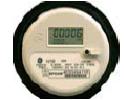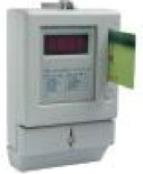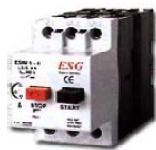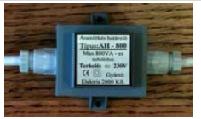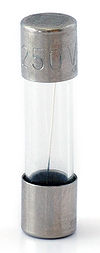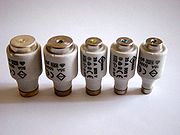Knowledge fuels change
For over a decade, Energypedia has shared free, reliable energy expertise with the world.
We’re now facing a serious funding gap.
Help keep this platform alive — your donation, big or small, truly matters!
Thank you for your support
Difference between revisions of "Metering and Billing Systems"
***** (***** | *****) m |
***** (***** | *****) m |
||
| (3 intermediate revisions by one other user not shown) | |||
| Line 1: | Line 1: | ||
| + | |||
= Overview = | = Overview = | ||
'''Net metering''' is a service to an electric consumer under which electric energy generated by that electric consumer from an eligible on-site generating facility and delivered to the local distribution facilities may be used to offset electric energy provided by the electric utility to the electric consumer during the applicable billing period.<ref>Wikipedia: http://en.wikipedia.org/wiki/Net_metering and http://www.ferc.gov/industries/electric/indus-act/section-1241.pdf</ref> | '''Net metering''' is a service to an electric consumer under which electric energy generated by that electric consumer from an eligible on-site generating facility and delivered to the local distribution facilities may be used to offset electric energy provided by the electric utility to the electric consumer during the applicable billing period.<ref>Wikipedia: http://en.wikipedia.org/wiki/Net_metering and http://www.ferc.gov/industries/electric/indus-act/section-1241.pdf</ref> | ||
| − | + | <br/> | |
= Billing<br/> = | = Billing<br/> = | ||
<u>Organising electricity distribution requires to determine:</u> | <u>Organising electricity distribution requires to determine:</u> | ||
| + | |||
*how much electricity is available | *how much electricity is available | ||
*how it is shared and limited | *how it is shared and limited | ||
| Line 16: | Line 18: | ||
<u>Different Tariff systems are practicable at different conditions:</u> | <u>Different Tariff systems are practicable at different conditions:</u> | ||
| − | (see also at [[ | + | (see also at [[Costs and Tariff Setting - Examples|Costs and Tariff Setting - Examples]]) |
| + | |||
*Flat tariffs unlimited/limited | *Flat tariffs unlimited/limited | ||
*Item based tariffs (pay per bulb/TV/Radio) | *Item based tariffs (pay per bulb/TV/Radio) | ||
| Line 27: | Line 30: | ||
<u>Advantages</u> | <u>Advantages</u> | ||
| − | {| cellspacing="1" cellpadding="1" border="0" align="right | + | {| style="width: 200px" class="FCK__ShowTableBorders" cellspacing="1" cellpadding="1" border="0" align="right" |
|- | |- | ||
| | | | ||
| Line 40: | Line 43: | ||
*allows amount and time related tariffs (demand steering) | *allows amount and time related tariffs (demand steering) | ||
| + | <br/> | ||
| + | <u>Disadvantages</u> | ||
| − | |||
*high costs (metering device) | *high costs (metering device) | ||
*especially at rural areas in dev. countries the investment cost for a meter unit are way out of range<br/> | *especially at rural areas in dev. countries the investment cost for a meter unit are way out of range<br/> | ||
*dis- and re-connection in case of late payment | *dis- and re-connection in case of late payment | ||
| − | + | <br/> | |
= Pre-paid System with Coins or Cards = | = Pre-paid System with Coins or Cards = | ||
[[File:Pre-paid system.jpg|thumb|right|143px|Pre-paid system]]<u>Advantages</u> | [[File:Pre-paid system.jpg|thumb|right|143px|Pre-paid system]]<u>Advantages</u> | ||
| + | |||
*fair and transparent | *fair and transparent | ||
*no meter reading | *no meter reading | ||
| Line 60: | Line 65: | ||
<u>Disadvantages</u> | <u>Disadvantages</u> | ||
| + | |||
*relatively high cost for metering device | *relatively high cost for metering device | ||
*less forgery proof | *less forgery proof | ||
*costs for re-collection of coins and selling system for coins/cards | *costs for re-collection of coins and selling system for coins/cards | ||
| − | + | <br/> | |
= Current Limiter / Fuses<br/> = | = Current Limiter / Fuses<br/> = | ||
| − | {| cellspacing="1" cellpadding="1" border="0" align="right | + | {| style="width: 200px" class="FCK__ShowTableBorders" cellspacing="1" cellpadding="1" border="0" align="right" |
|- | |- | ||
| [[File:Current limiter 2.jpg|thumb|right|156px|fault current breaker|alt=fault current breaker]] | | [[File:Current limiter 2.jpg|thumb|right|156px|fault current breaker|alt=fault current breaker]] | ||
| Line 78: | Line 84: | ||
<u>Advantages</u> | <u>Advantages</u> | ||
| + | |||
*simultaneously protecting against overcurrent (actual purpose) | *simultaneously protecting against overcurrent (actual purpose) | ||
*cheap if simple versions<br/> | *cheap if simple versions<br/> | ||
*no meter reading required => indirect power flat rate according to max. amperage | *no meter reading required => indirect power flat rate according to max. amperage | ||
| + | <br/> | ||
| + | <u>Disadvantages</u> | ||
| − | |||
*accuracy of cicuit breakers as load limiter fluctuates (even items from one batch have different trigger levels)<br/>=> neigbours with same connections may be able to use different wattage<br/> | *accuracy of cicuit breakers as load limiter fluctuates (even items from one batch have different trigger levels)<br/>=> neigbours with same connections may be able to use different wattage<br/> | ||
*fault current breaker are rarely available in < 1 Ampere range (1 A / 220 V => 220 Watt)<br/> | *fault current breaker are rarely available in < 1 Ampere range (1 A / 220 V => 220 Watt)<br/> | ||
| Line 102: | Line 110: | ||
Often such settings work only until the limit of the mhp is reached and power has to be rationed. | Often such settings work only until the limit of the mhp is reached and power has to be rationed. | ||
| + | <br/> | ||
| + | <u>Advantages</u> | ||
| − | |||
*very cheap (no metering or limiting device) | *very cheap (no metering or limiting device) | ||
*in rural areas of Indonesia common and accepted as long lighting is the common/only usage<br/> | *in rural areas of Indonesia common and accepted as long lighting is the common/only usage<br/> | ||
| Line 110: | Line 119: | ||
<u>Disadvantages</u> | <u>Disadvantages</u> | ||
| + | |||
*provokes waste of electricity, no incentive for saving | *provokes waste of electricity, no incentive for saving | ||
*no load control / demand steering possible (peaks) | *no load control / demand steering possible (peaks) | ||
*can be unfair | *can be unfair | ||
| − | + | <br/> | |
= Further Information = | = Further Information = | ||
| Line 120: | Line 130: | ||
*[[Metering and Billing Battery Charging Systems (BCS)|Metering and Billing Battery Charging Systems (BCS)]]<br/> | *[[Metering and Billing Battery Charging Systems (BCS)|Metering and Billing Battery Charging Systems (BCS)]]<br/> | ||
*[[Net Metering|Net Metering]]<br/> | *[[Net Metering|Net Metering]]<br/> | ||
| − | *[[ | + | *[[Net Metering in Brazil|Net Metering in Brazil]]<br/> |
| − | |||
| + | <br/> | ||
= References = | = References = | ||
| Line 128: | Line 138: | ||
<references /><br/> | <references /><br/> | ||
| + | [[Category:Net_Metering]] | ||
| + | [[Category:Digitalisation]] | ||
| + | [[Category:Net_Metering_Brazil]] | ||
| + | [[Category:Electricity]] | ||
[[Category:Feed-in_Tariffs]] | [[Category:Feed-in_Tariffs]] | ||
| − | |||
| − | |||
| − | |||
Latest revision as of 07:25, 3 September 2019
Overview
Net metering is a service to an electric consumer under which electric energy generated by that electric consumer from an eligible on-site generating facility and delivered to the local distribution facilities may be used to offset electric energy provided by the electric utility to the electric consumer during the applicable billing period.[1]
Billing
Organising electricity distribution requires to determine:
- how much electricity is available
- how it is shared and limited
- how are the individual costs (tariffs) to be set
Different Tariff systems are practicable at different conditions:
(see also at Costs and Tariff Setting - Examples)
- Flat tariffs unlimited/limited
- Item based tariffs (pay per bulb/TV/Radio)
- Pay per usage (requires metering)
Standard kWh Meter
Advantages
- technique is "state of the art"
- billing is fair and transparent
- reading can be uncoupled from tariff collection
- allows amount and time related tariffs (demand steering)
Disadvantages
- high costs (metering device)
- especially at rural areas in dev. countries the investment cost for a meter unit are way out of range
- dis- and re-connection in case of late payment
Pre-paid System with Coins or Cards
Advantages
- fair and transparent
- no meter reading
- no overdue costs
- no costs for dis- and re-connection
- close to “ability to pay”-variations
- coins less expensive than cards
Disadvantages
- relatively high cost for metering device
- less forgery proof
- costs for re-collection of coins and selling system for coins/cards
Current Limiter / Fuses
Advantages
- simultaneously protecting against overcurrent (actual purpose)
- cheap if simple versions
- no meter reading required => indirect power flat rate according to max. amperage
Disadvantages
- accuracy of cicuit breakers as load limiter fluctuates (even items from one batch have different trigger levels)
=> neigbours with same connections may be able to use different wattage - fault current breaker are rarely available in < 1 Ampere range (1 A / 220 V => 220 Watt)
- time of usage not considered; less fair
- melting fuses are available and cheap but very easy to bridge (also temporarily) => encourage misuse
Flat Rate / No Metering / No Limiting
Only in well organised small communities a flat rate without limiting or metering will work. Consumers have to agree that everybody connected carries the same share of payment. If usage of electricity differs widely between the connected parties usually the "one tariff for all" is considered unfair.
Often such settings work only until the limit of the mhp is reached and power has to be rationed.
Advantages
- very cheap (no metering or limiting device)
- in rural areas of Indonesia common and accepted as long lighting is the common/only usage
- can be combined with number of appliances or installed wattage (social control)
Disadvantages
- provokes waste of electricity, no incentive for saving
- no load control / demand steering possible (peaks)
- can be unfair
Further Information

